Report: Restrictive Practices, Impacts, and Legal Rights in Aged Care
VerifiedAdded on 2022/12/29
|10
|2461
|89
Report
AI Summary
This report provides a comprehensive analysis of restrictive practices in residential aged care settings. It begins with an introduction to restrictive practices, defining both physical and pharmacological restraints. The report delves into the impacts of these practices, highlighting the physical and psychological harm they can inflict on residents, including increased risks of falls, injuries, and mental health issues. It explores the adverse outcomes associated with physical restraint, such as injuries and psychological distress. The report also examines the legal rights and considerations surrounding the use of restraint, emphasizing the need for consultation, documentation, and the exploration of alternatives. Finally, the report concludes by underscoring the importance of understanding these practices to improve the quality of inpatient mental healthcare and patient well-being. The report advocates for the use of restraint as a last resort and emphasizes the importance of staff training and therapeutic alliances to reduce restrictive interventions.
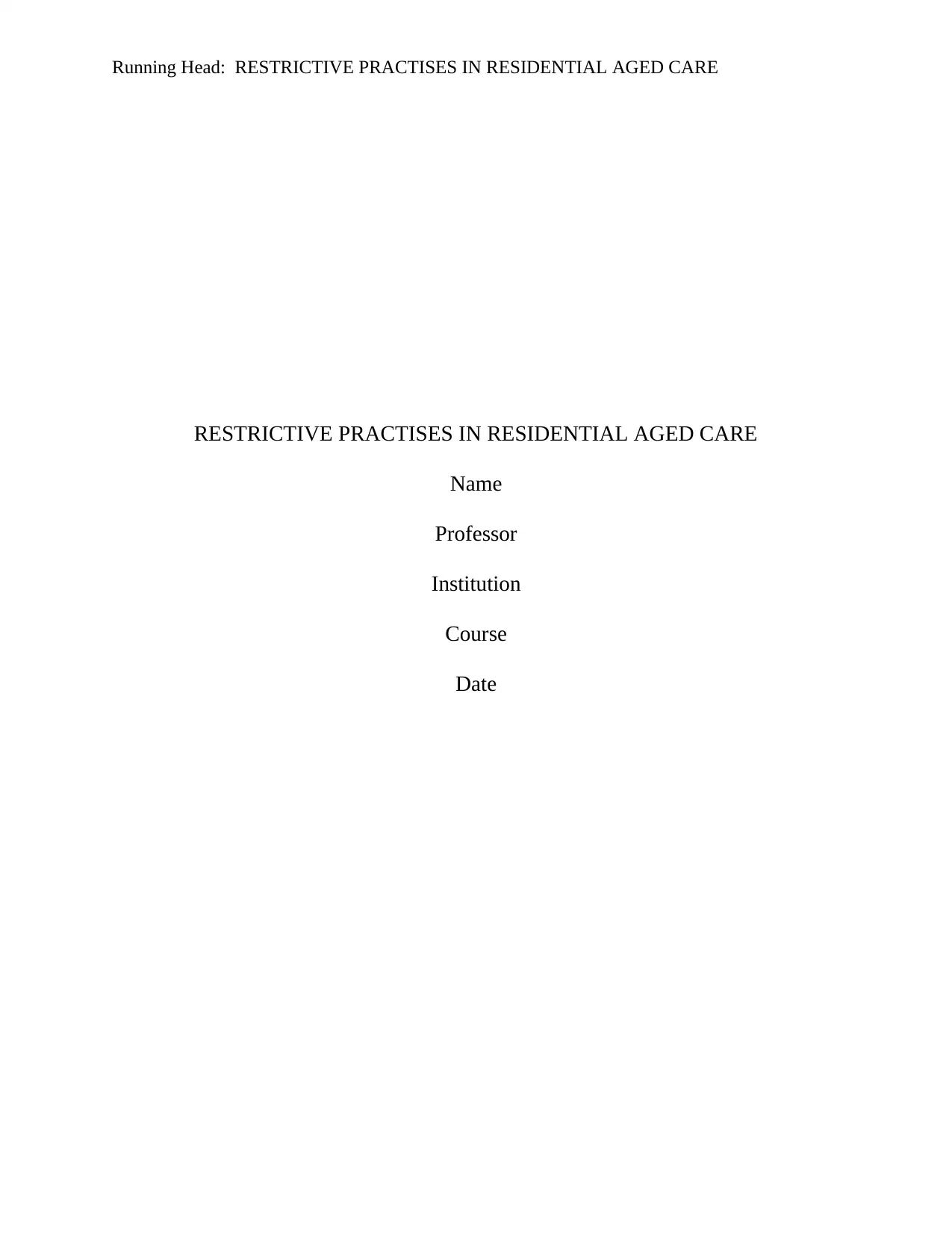
Running Head: RESTRICTIVE PRACTISES IN RESIDENTIAL AGED CARE
RESTRICTIVE PRACTISES IN RESIDENTIAL AGED CARE
Name
Professor
Institution
Course
Date
RESTRICTIVE PRACTISES IN RESIDENTIAL AGED CARE
Name
Professor
Institution
Course
Date
Paraphrase This Document
Need a fresh take? Get an instant paraphrase of this document with our AI Paraphraser
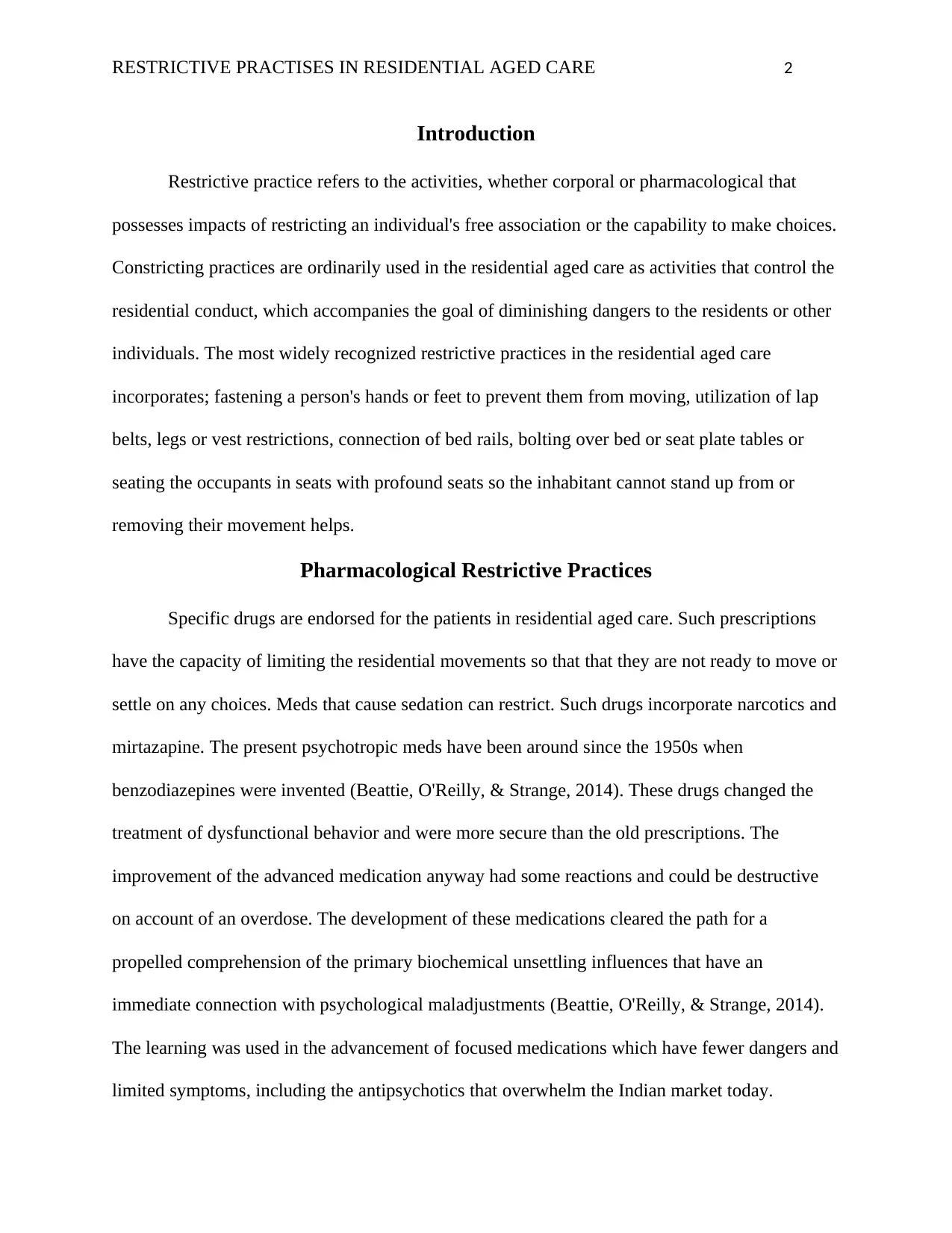
RESTRICTIVE PRACTISES IN RESIDENTIAL AGED CARE 2
Introduction
Restrictive practice refers to the activities, whether corporal or pharmacological that
possesses impacts of restricting an individual's free association or the capability to make choices.
Constricting practices are ordinarily used in the residential aged care as activities that control the
residential conduct, which accompanies the goal of diminishing dangers to the residents or other
individuals. The most widely recognized restrictive practices in the residential aged care
incorporates; fastening a person's hands or feet to prevent them from moving, utilization of lap
belts, legs or vest restrictions, connection of bed rails, bolting over bed or seat plate tables or
seating the occupants in seats with profound seats so the inhabitant cannot stand up from or
removing their movement helps.
Pharmacological Restrictive Practices
Specific drugs are endorsed for the patients in residential aged care. Such prescriptions
have the capacity of limiting the residential movements so that that they are not ready to move or
settle on any choices. Meds that cause sedation can restrict. Such drugs incorporate narcotics and
mirtazapine. The present psychotropic meds have been around since the 1950s when
benzodiazepines were invented (Beattie, O'Reilly, & Strange, 2014). These drugs changed the
treatment of dysfunctional behavior and were more secure than the old prescriptions. The
improvement of the advanced medication anyway had some reactions and could be destructive
on account of an overdose. The development of these medications cleared the path for a
propelled comprehension of the primary biochemical unsettling influences that have an
immediate connection with psychological maladjustments (Beattie, O'Reilly, & Strange, 2014).
The learning was used in the advancement of focused medications which have fewer dangers and
limited symptoms, including the antipsychotics that overwhelm the Indian market today.
Introduction
Restrictive practice refers to the activities, whether corporal or pharmacological that
possesses impacts of restricting an individual's free association or the capability to make choices.
Constricting practices are ordinarily used in the residential aged care as activities that control the
residential conduct, which accompanies the goal of diminishing dangers to the residents or other
individuals. The most widely recognized restrictive practices in the residential aged care
incorporates; fastening a person's hands or feet to prevent them from moving, utilization of lap
belts, legs or vest restrictions, connection of bed rails, bolting over bed or seat plate tables or
seating the occupants in seats with profound seats so the inhabitant cannot stand up from or
removing their movement helps.
Pharmacological Restrictive Practices
Specific drugs are endorsed for the patients in residential aged care. Such prescriptions
have the capacity of limiting the residential movements so that that they are not ready to move or
settle on any choices. Meds that cause sedation can restrict. Such drugs incorporate narcotics and
mirtazapine. The present psychotropic meds have been around since the 1950s when
benzodiazepines were invented (Beattie, O'Reilly, & Strange, 2014). These drugs changed the
treatment of dysfunctional behavior and were more secure than the old prescriptions. The
improvement of the advanced medication anyway had some reactions and could be destructive
on account of an overdose. The development of these medications cleared the path for a
propelled comprehension of the primary biochemical unsettling influences that have an
immediate connection with psychological maladjustments (Beattie, O'Reilly, & Strange, 2014).
The learning was used in the advancement of focused medications which have fewer dangers and
limited symptoms, including the antipsychotics that overwhelm the Indian market today.
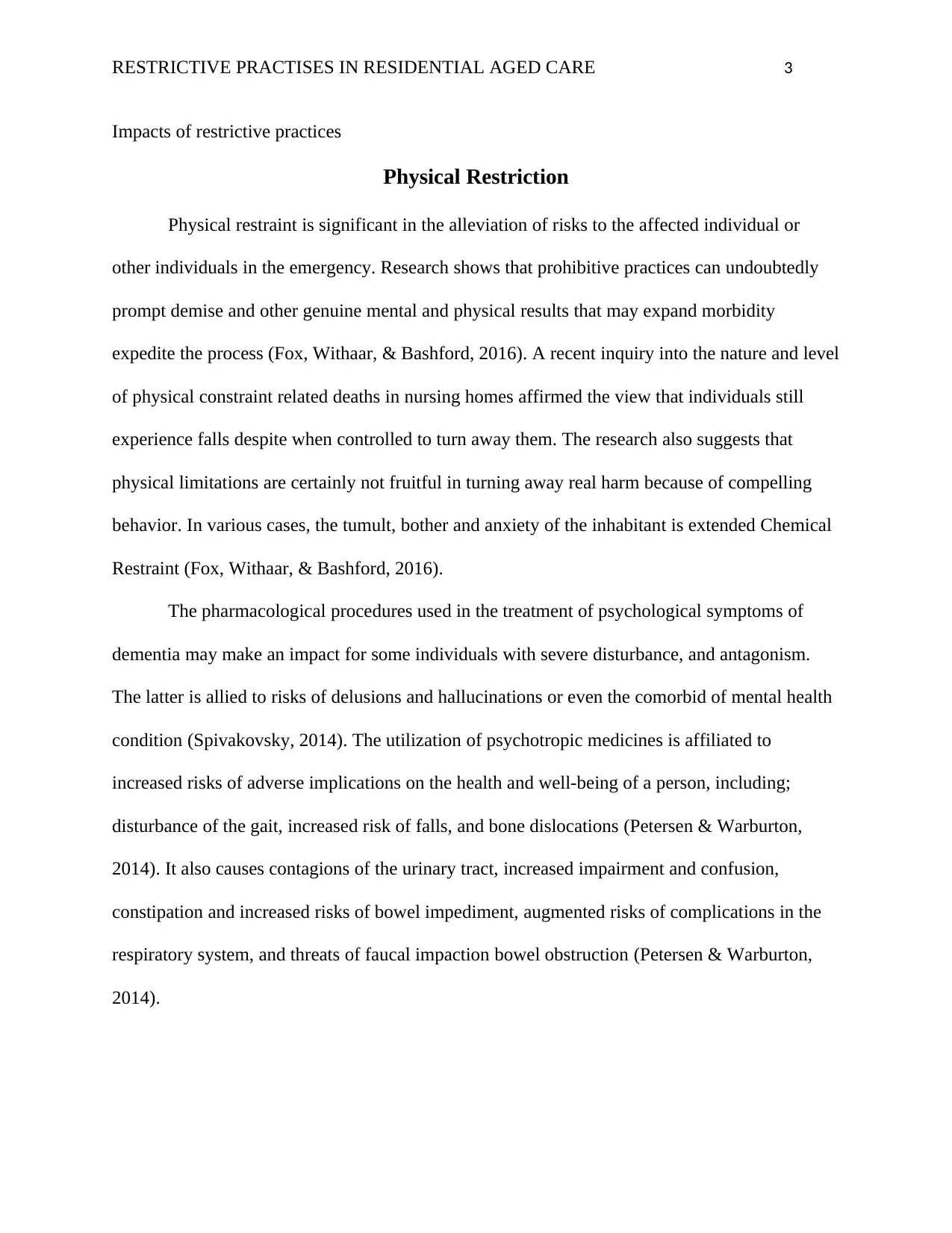
RESTRICTIVE PRACTISES IN RESIDENTIAL AGED CARE 3
Impacts of restrictive practices
Physical Restriction
Physical restraint is significant in the alleviation of risks to the affected individual or
other individuals in the emergency. Research shows that prohibitive practices can undoubtedly
prompt demise and other genuine mental and physical results that may expand morbidity
expedite the process (Fox, Withaar, & Bashford, 2016). A recent inquiry into the nature and level
of physical constraint related deaths in nursing homes affirmed the view that individuals still
experience falls despite when controlled to turn away them. The research also suggests that
physical limitations are certainly not fruitful in turning away real harm because of compelling
behavior. In various cases, the tumult, bother and anxiety of the inhabitant is extended Chemical
Restraint (Fox, Withaar, & Bashford, 2016).
The pharmacological procedures used in the treatment of psychological symptoms of
dementia may make an impact for some individuals with severe disturbance, and antagonism.
The latter is allied to risks of delusions and hallucinations or even the comorbid of mental health
condition (Spivakovsky, 2014). The utilization of psychotropic medicines is affiliated to
increased risks of adverse implications on the health and well-being of a person, including;
disturbance of the gait, increased risk of falls, and bone dislocations (Petersen & Warburton,
2014). It also causes contagions of the urinary tract, increased impairment and confusion,
constipation and increased risks of bowel impediment, augmented risks of complications in the
respiratory system, and threats of faucal impaction bowel obstruction (Petersen & Warburton,
2014).
Impacts of restrictive practices
Physical Restriction
Physical restraint is significant in the alleviation of risks to the affected individual or
other individuals in the emergency. Research shows that prohibitive practices can undoubtedly
prompt demise and other genuine mental and physical results that may expand morbidity
expedite the process (Fox, Withaar, & Bashford, 2016). A recent inquiry into the nature and level
of physical constraint related deaths in nursing homes affirmed the view that individuals still
experience falls despite when controlled to turn away them. The research also suggests that
physical limitations are certainly not fruitful in turning away real harm because of compelling
behavior. In various cases, the tumult, bother and anxiety of the inhabitant is extended Chemical
Restraint (Fox, Withaar, & Bashford, 2016).
The pharmacological procedures used in the treatment of psychological symptoms of
dementia may make an impact for some individuals with severe disturbance, and antagonism.
The latter is allied to risks of delusions and hallucinations or even the comorbid of mental health
condition (Spivakovsky, 2014). The utilization of psychotropic medicines is affiliated to
increased risks of adverse implications on the health and well-being of a person, including;
disturbance of the gait, increased risk of falls, and bone dislocations (Petersen & Warburton,
2014). It also causes contagions of the urinary tract, increased impairment and confusion,
constipation and increased risks of bowel impediment, augmented risks of complications in the
respiratory system, and threats of faucal impaction bowel obstruction (Petersen & Warburton,
2014).
⊘ This is a preview!⊘
Do you want full access?
Subscribe today to unlock all pages.

Trusted by 1+ million students worldwide
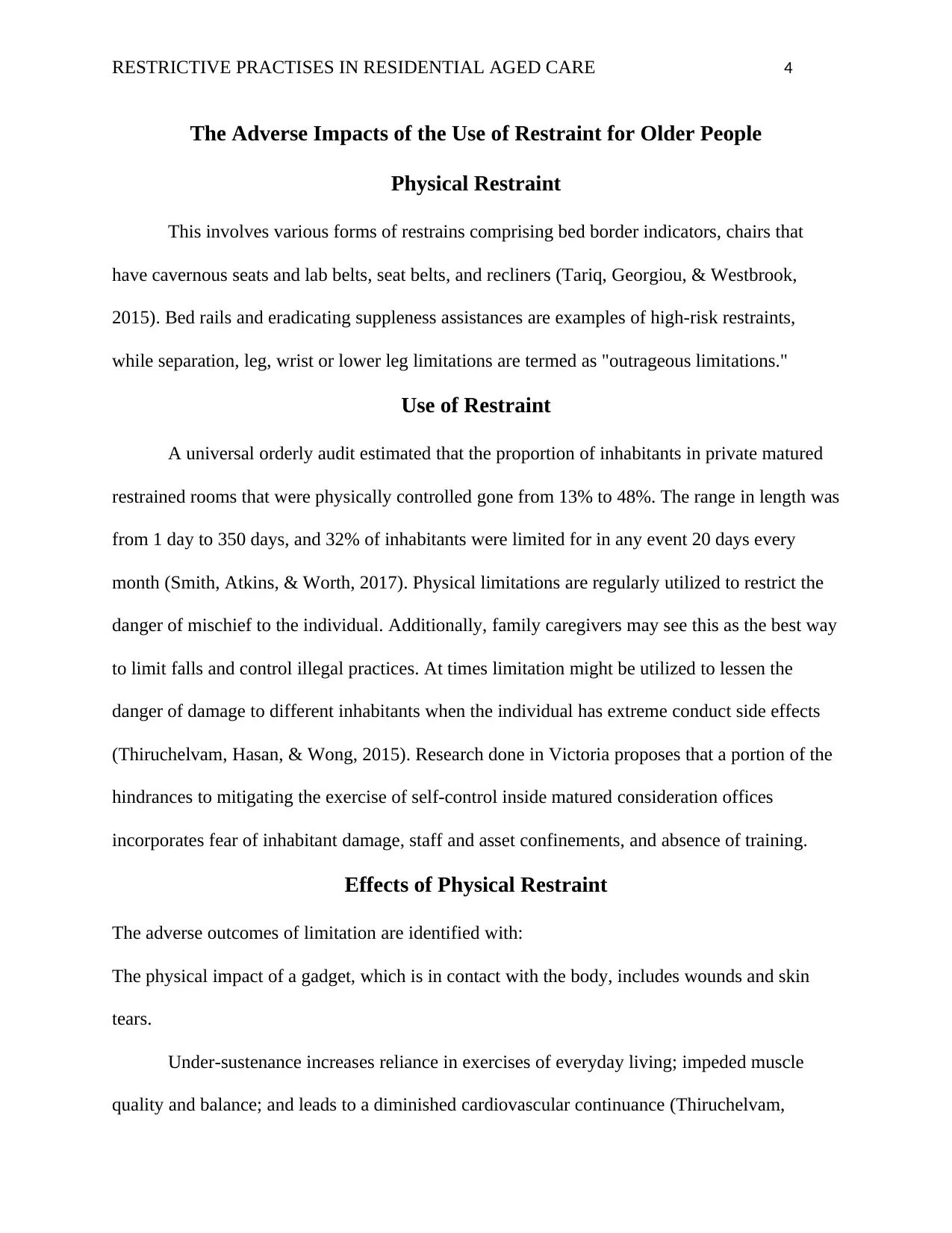
RESTRICTIVE PRACTISES IN RESIDENTIAL AGED CARE 4
The Adverse Impacts of the Use of Restraint for Older People
Physical Restraint
This involves various forms of restrains comprising bed border indicators, chairs that
have cavernous seats and lab belts, seat belts, and recliners (Tariq, Georgiou, & Westbrook,
2015). Bed rails and eradicating suppleness assistances are examples of high-risk restraints,
while separation, leg, wrist or lower leg limitations are termed as "outrageous limitations."
Use of Restraint
A universal orderly audit estimated that the proportion of inhabitants in private matured
restrained rooms that were physically controlled gone from 13% to 48%. The range in length was
from 1 day to 350 days, and 32% of inhabitants were limited for in any event 20 days every
month (Smith, Atkins, & Worth, 2017). Physical limitations are regularly utilized to restrict the
danger of mischief to the individual. Additionally, family caregivers may see this as the best way
to limit falls and control illegal practices. At times limitation might be utilized to lessen the
danger of damage to different inhabitants when the individual has extreme conduct side effects
(Thiruchelvam, Hasan, & Wong, 2015). Research done in Victoria proposes that a portion of the
hindrances to mitigating the exercise of self-control inside matured consideration offices
incorporates fear of inhabitant damage, staff and asset confinements, and absence of training.
Effects of Physical Restraint
The adverse outcomes of limitation are identified with:
The physical impact of a gadget, which is in contact with the body, includes wounds and skin
tears.
Under-sustenance increases reliance in exercises of everyday living; impeded muscle
quality and balance; and leads to a diminished cardiovascular continuance (Thiruchelvam,
The Adverse Impacts of the Use of Restraint for Older People
Physical Restraint
This involves various forms of restrains comprising bed border indicators, chairs that
have cavernous seats and lab belts, seat belts, and recliners (Tariq, Georgiou, & Westbrook,
2015). Bed rails and eradicating suppleness assistances are examples of high-risk restraints,
while separation, leg, wrist or lower leg limitations are termed as "outrageous limitations."
Use of Restraint
A universal orderly audit estimated that the proportion of inhabitants in private matured
restrained rooms that were physically controlled gone from 13% to 48%. The range in length was
from 1 day to 350 days, and 32% of inhabitants were limited for in any event 20 days every
month (Smith, Atkins, & Worth, 2017). Physical limitations are regularly utilized to restrict the
danger of mischief to the individual. Additionally, family caregivers may see this as the best way
to limit falls and control illegal practices. At times limitation might be utilized to lessen the
danger of damage to different inhabitants when the individual has extreme conduct side effects
(Thiruchelvam, Hasan, & Wong, 2015). Research done in Victoria proposes that a portion of the
hindrances to mitigating the exercise of self-control inside matured consideration offices
incorporates fear of inhabitant damage, staff and asset confinements, and absence of training.
Effects of Physical Restraint
The adverse outcomes of limitation are identified with:
The physical impact of a gadget, which is in contact with the body, includes wounds and skin
tears.
Under-sustenance increases reliance in exercises of everyday living; impeded muscle
quality and balance; and leads to a diminished cardiovascular continuance (Thiruchelvam,
Paraphrase This Document
Need a fresh take? Get an instant paraphrase of this document with our AI Paraphraser
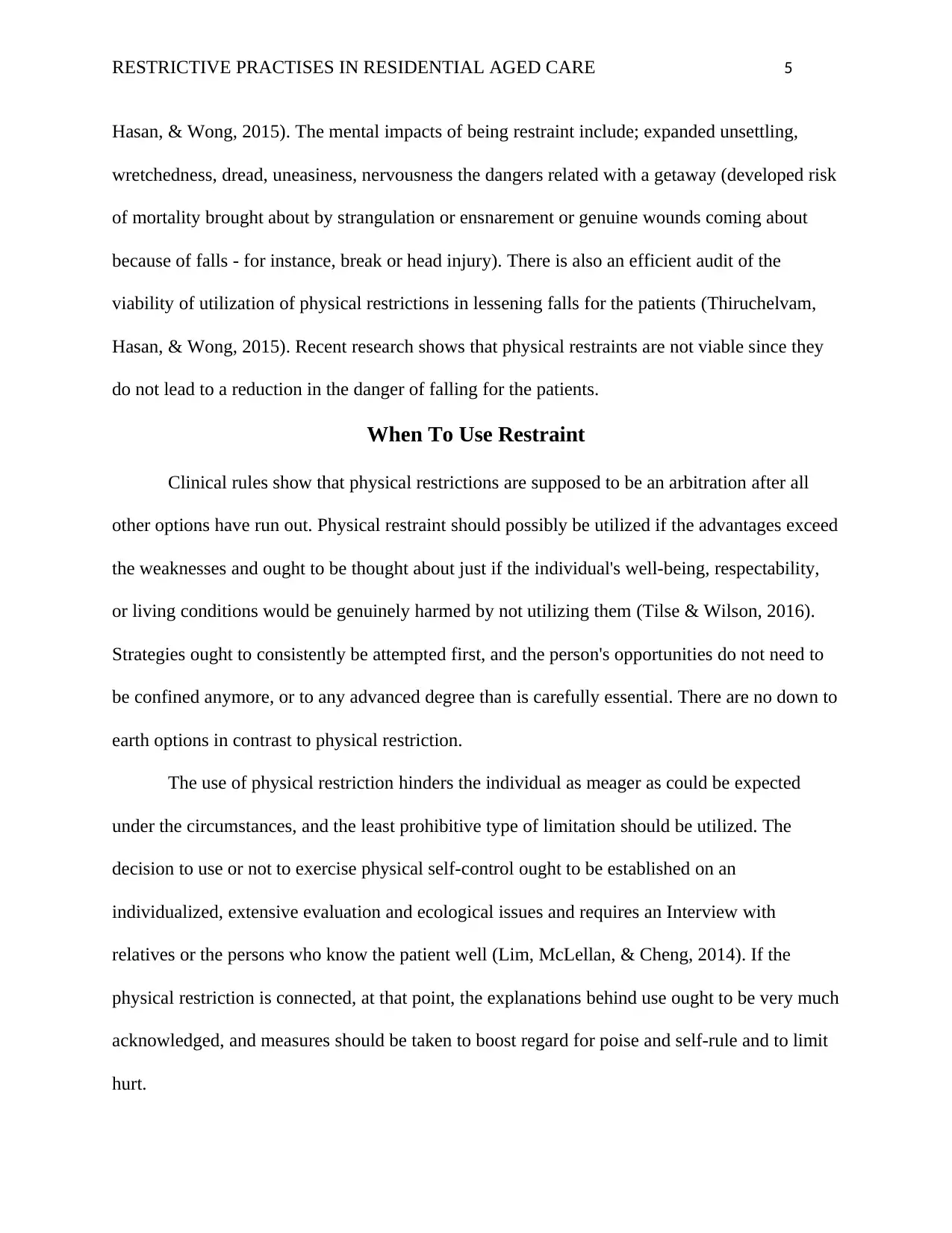
RESTRICTIVE PRACTISES IN RESIDENTIAL AGED CARE 5
Hasan, & Wong, 2015). The mental impacts of being restraint include; expanded unsettling,
wretchedness, dread, uneasiness, nervousness the dangers related with a getaway (developed risk
of mortality brought about by strangulation or ensnarement or genuine wounds coming about
because of falls - for instance, break or head injury). There is also an efficient audit of the
viability of utilization of physical restrictions in lessening falls for the patients (Thiruchelvam,
Hasan, & Wong, 2015). Recent research shows that physical restraints are not viable since they
do not lead to a reduction in the danger of falling for the patients.
When To Use Restraint
Clinical rules show that physical restrictions are supposed to be an arbitration after all
other options have run out. Physical restraint should possibly be utilized if the advantages exceed
the weaknesses and ought to be thought about just if the individual's well-being, respectability,
or living conditions would be genuinely harmed by not utilizing them (Tilse & Wilson, 2016).
Strategies ought to consistently be attempted first, and the person's opportunities do not need to
be confined anymore, or to any advanced degree than is carefully essential. There are no down to
earth options in contrast to physical restriction.
The use of physical restriction hinders the individual as meager as could be expected
under the circumstances, and the least prohibitive type of limitation should be utilized. The
decision to use or not to exercise physical self-control ought to be established on an
individualized, extensive evaluation and ecological issues and requires an Interview with
relatives or the persons who know the patient well (Lim, McLellan, & Cheng, 2014). If the
physical restriction is connected, at that point, the explanations behind use ought to be very much
acknowledged, and measures should be taken to boost regard for poise and self-rule and to limit
hurt.
Hasan, & Wong, 2015). The mental impacts of being restraint include; expanded unsettling,
wretchedness, dread, uneasiness, nervousness the dangers related with a getaway (developed risk
of mortality brought about by strangulation or ensnarement or genuine wounds coming about
because of falls - for instance, break or head injury). There is also an efficient audit of the
viability of utilization of physical restrictions in lessening falls for the patients (Thiruchelvam,
Hasan, & Wong, 2015). Recent research shows that physical restraints are not viable since they
do not lead to a reduction in the danger of falling for the patients.
When To Use Restraint
Clinical rules show that physical restrictions are supposed to be an arbitration after all
other options have run out. Physical restraint should possibly be utilized if the advantages exceed
the weaknesses and ought to be thought about just if the individual's well-being, respectability,
or living conditions would be genuinely harmed by not utilizing them (Tilse & Wilson, 2016).
Strategies ought to consistently be attempted first, and the person's opportunities do not need to
be confined anymore, or to any advanced degree than is carefully essential. There are no down to
earth options in contrast to physical restriction.
The use of physical restriction hinders the individual as meager as could be expected
under the circumstances, and the least prohibitive type of limitation should be utilized. The
decision to use or not to exercise physical self-control ought to be established on an
individualized, extensive evaluation and ecological issues and requires an Interview with
relatives or the persons who know the patient well (Lim, McLellan, & Cheng, 2014). If the
physical restriction is connected, at that point, the explanations behind use ought to be very much
acknowledged, and measures should be taken to boost regard for poise and self-rule and to limit
hurt.
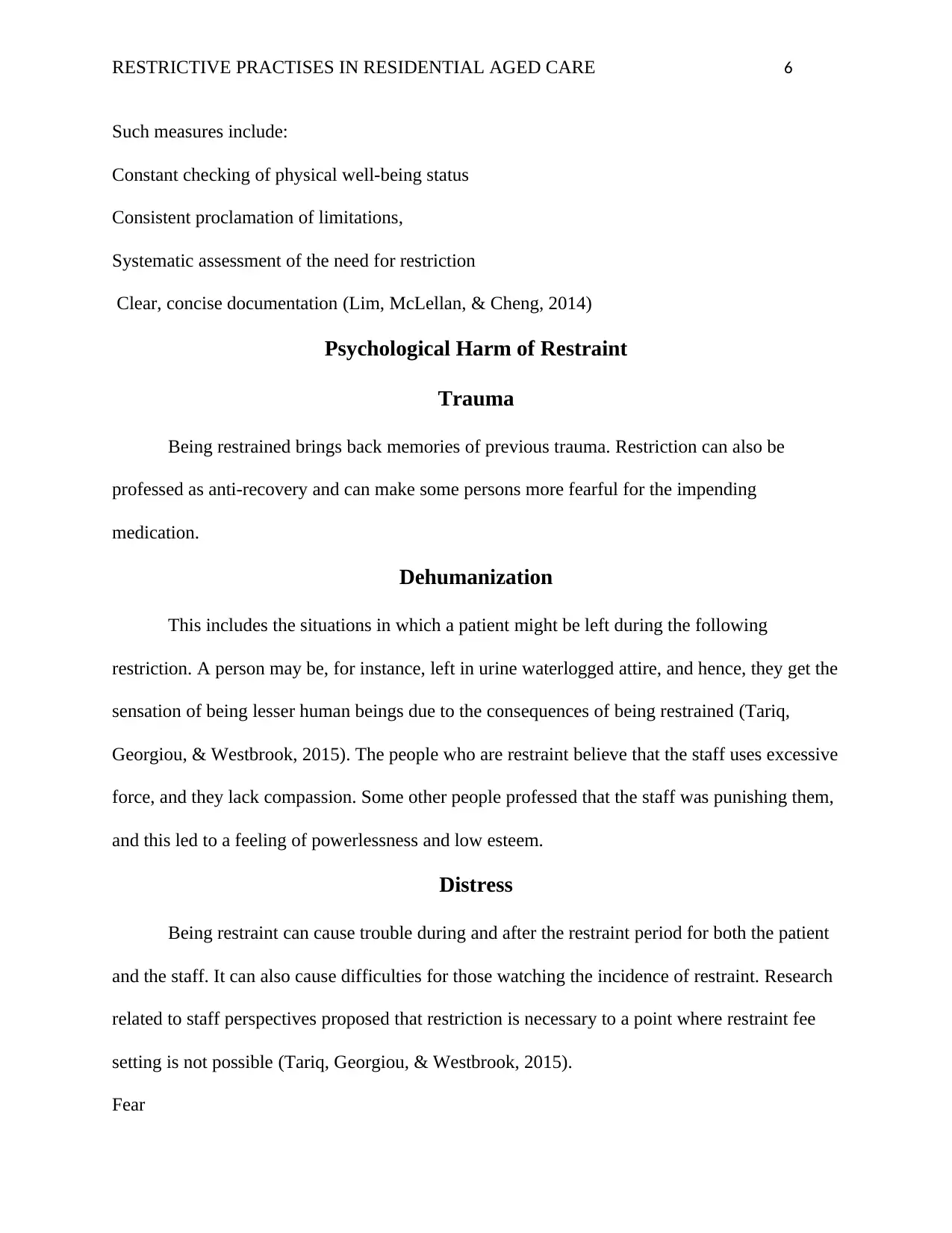
RESTRICTIVE PRACTISES IN RESIDENTIAL AGED CARE 6
Such measures include:
Constant checking of physical well-being status
Consistent proclamation of limitations,
Systematic assessment of the need for restriction
Clear, concise documentation (Lim, McLellan, & Cheng, 2014)
Psychological Harm of Restraint
Trauma
Being restrained brings back memories of previous trauma. Restriction can also be
professed as anti-recovery and can make some persons more fearful for the impending
medication.
Dehumanization
This includes the situations in which a patient might be left during the following
restriction. A person may be, for instance, left in urine waterlogged attire, and hence, they get the
sensation of being lesser human beings due to the consequences of being restrained (Tariq,
Georgiou, & Westbrook, 2015). The people who are restraint believe that the staff uses excessive
force, and they lack compassion. Some other people professed that the staff was punishing them,
and this led to a feeling of powerlessness and low esteem.
Distress
Being restraint can cause trouble during and after the restraint period for both the patient
and the staff. It can also cause difficulties for those watching the incidence of restraint. Research
related to staff perspectives proposed that restriction is necessary to a point where restraint fee
setting is not possible (Tariq, Georgiou, & Westbrook, 2015).
Fear
Such measures include:
Constant checking of physical well-being status
Consistent proclamation of limitations,
Systematic assessment of the need for restriction
Clear, concise documentation (Lim, McLellan, & Cheng, 2014)
Psychological Harm of Restraint
Trauma
Being restrained brings back memories of previous trauma. Restriction can also be
professed as anti-recovery and can make some persons more fearful for the impending
medication.
Dehumanization
This includes the situations in which a patient might be left during the following
restriction. A person may be, for instance, left in urine waterlogged attire, and hence, they get the
sensation of being lesser human beings due to the consequences of being restrained (Tariq,
Georgiou, & Westbrook, 2015). The people who are restraint believe that the staff uses excessive
force, and they lack compassion. Some other people professed that the staff was punishing them,
and this led to a feeling of powerlessness and low esteem.
Distress
Being restraint can cause trouble during and after the restraint period for both the patient
and the staff. It can also cause difficulties for those watching the incidence of restraint. Research
related to staff perspectives proposed that restriction is necessary to a point where restraint fee
setting is not possible (Tariq, Georgiou, & Westbrook, 2015).
Fear
⊘ This is a preview!⊘
Do you want full access?
Subscribe today to unlock all pages.

Trusted by 1+ million students worldwide
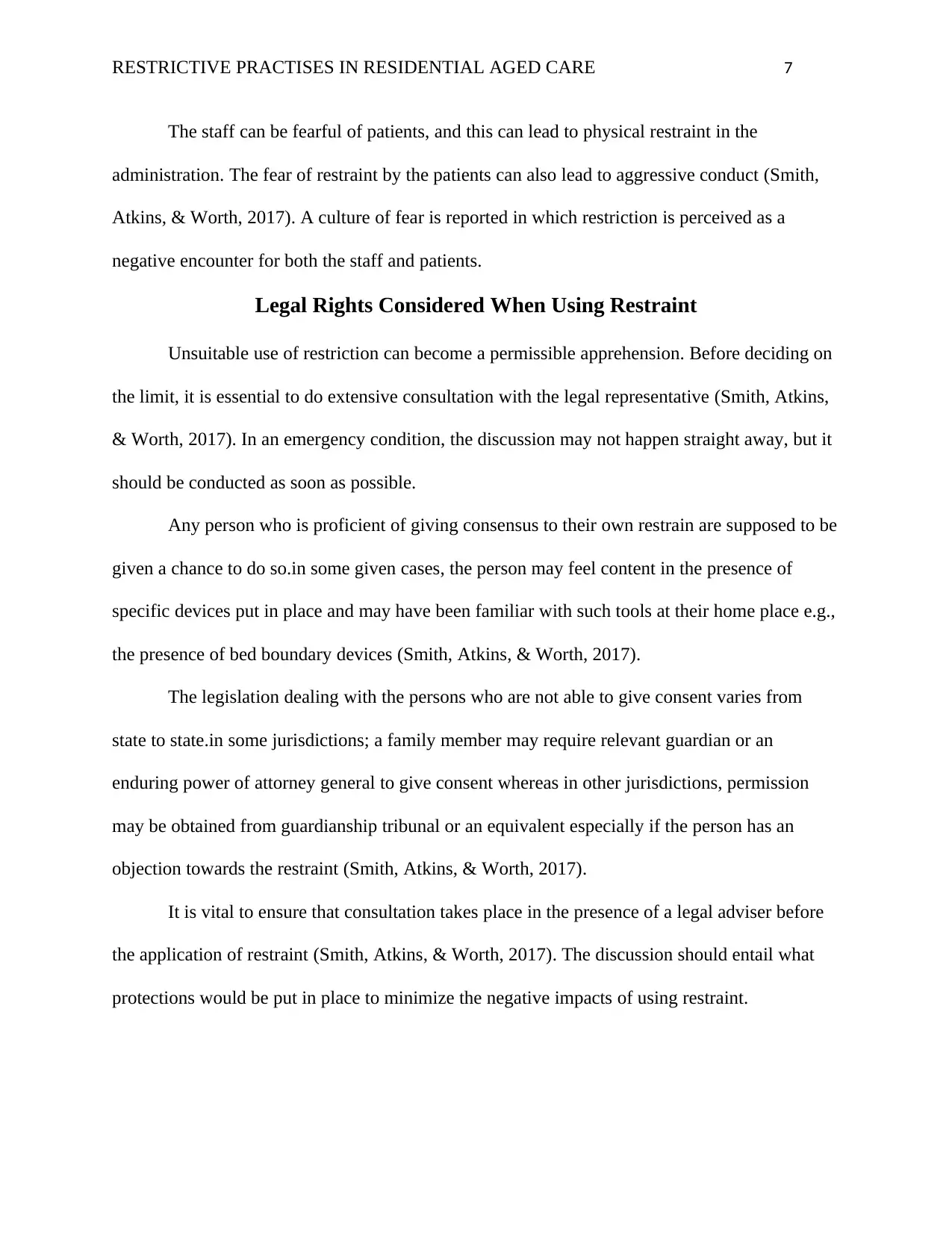
RESTRICTIVE PRACTISES IN RESIDENTIAL AGED CARE 7
The staff can be fearful of patients, and this can lead to physical restraint in the
administration. The fear of restraint by the patients can also lead to aggressive conduct (Smith,
Atkins, & Worth, 2017). A culture of fear is reported in which restriction is perceived as a
negative encounter for both the staff and patients.
Legal Rights Considered When Using Restraint
Unsuitable use of restriction can become a permissible apprehension. Before deciding on
the limit, it is essential to do extensive consultation with the legal representative (Smith, Atkins,
& Worth, 2017). In an emergency condition, the discussion may not happen straight away, but it
should be conducted as soon as possible.
Any person who is proficient of giving consensus to their own restrain are supposed to be
given a chance to do so.in some given cases, the person may feel content in the presence of
specific devices put in place and may have been familiar with such tools at their home place e.g.,
the presence of bed boundary devices (Smith, Atkins, & Worth, 2017).
The legislation dealing with the persons who are not able to give consent varies from
state to state.in some jurisdictions; a family member may require relevant guardian or an
enduring power of attorney general to give consent whereas in other jurisdictions, permission
may be obtained from guardianship tribunal or an equivalent especially if the person has an
objection towards the restraint (Smith, Atkins, & Worth, 2017).
It is vital to ensure that consultation takes place in the presence of a legal adviser before
the application of restraint (Smith, Atkins, & Worth, 2017). The discussion should entail what
protections would be put in place to minimize the negative impacts of using restraint.
The staff can be fearful of patients, and this can lead to physical restraint in the
administration. The fear of restraint by the patients can also lead to aggressive conduct (Smith,
Atkins, & Worth, 2017). A culture of fear is reported in which restriction is perceived as a
negative encounter for both the staff and patients.
Legal Rights Considered When Using Restraint
Unsuitable use of restriction can become a permissible apprehension. Before deciding on
the limit, it is essential to do extensive consultation with the legal representative (Smith, Atkins,
& Worth, 2017). In an emergency condition, the discussion may not happen straight away, but it
should be conducted as soon as possible.
Any person who is proficient of giving consensus to their own restrain are supposed to be
given a chance to do so.in some given cases, the person may feel content in the presence of
specific devices put in place and may have been familiar with such tools at their home place e.g.,
the presence of bed boundary devices (Smith, Atkins, & Worth, 2017).
The legislation dealing with the persons who are not able to give consent varies from
state to state.in some jurisdictions; a family member may require relevant guardian or an
enduring power of attorney general to give consent whereas in other jurisdictions, permission
may be obtained from guardianship tribunal or an equivalent especially if the person has an
objection towards the restraint (Smith, Atkins, & Worth, 2017).
It is vital to ensure that consultation takes place in the presence of a legal adviser before
the application of restraint (Smith, Atkins, & Worth, 2017). The discussion should entail what
protections would be put in place to minimize the negative impacts of using restraint.
Paraphrase This Document
Need a fresh take? Get an instant paraphrase of this document with our AI Paraphraser
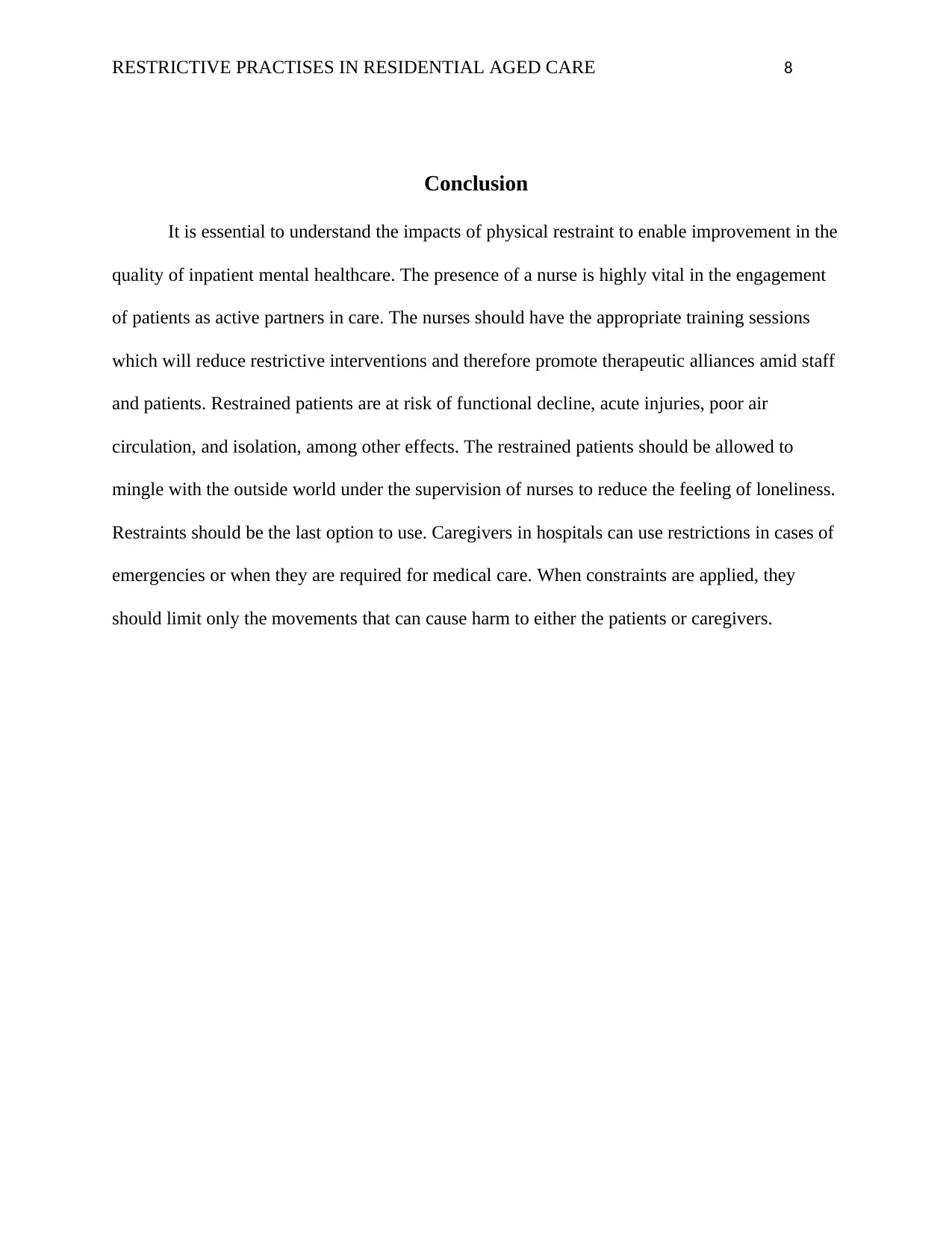
RESTRICTIVE PRACTISES IN RESIDENTIAL AGED CARE 8
Conclusion
It is essential to understand the impacts of physical restraint to enable improvement in the
quality of inpatient mental healthcare. The presence of a nurse is highly vital in the engagement
of patients as active partners in care. The nurses should have the appropriate training sessions
which will reduce restrictive interventions and therefore promote therapeutic alliances amid staff
and patients. Restrained patients are at risk of functional decline, acute injuries, poor air
circulation, and isolation, among other effects. The restrained patients should be allowed to
mingle with the outside world under the supervision of nurses to reduce the feeling of loneliness.
Restraints should be the last option to use. Caregivers in hospitals can use restrictions in cases of
emergencies or when they are required for medical care. When constraints are applied, they
should limit only the movements that can cause harm to either the patients or caregivers.
Conclusion
It is essential to understand the impacts of physical restraint to enable improvement in the
quality of inpatient mental healthcare. The presence of a nurse is highly vital in the engagement
of patients as active partners in care. The nurses should have the appropriate training sessions
which will reduce restrictive interventions and therefore promote therapeutic alliances amid staff
and patients. Restrained patients are at risk of functional decline, acute injuries, poor air
circulation, and isolation, among other effects. The restrained patients should be allowed to
mingle with the outside world under the supervision of nurses to reduce the feeling of loneliness.
Restraints should be the last option to use. Caregivers in hospitals can use restrictions in cases of
emergencies or when they are required for medical care. When constraints are applied, they
should limit only the movements that can cause harm to either the patients or caregivers.
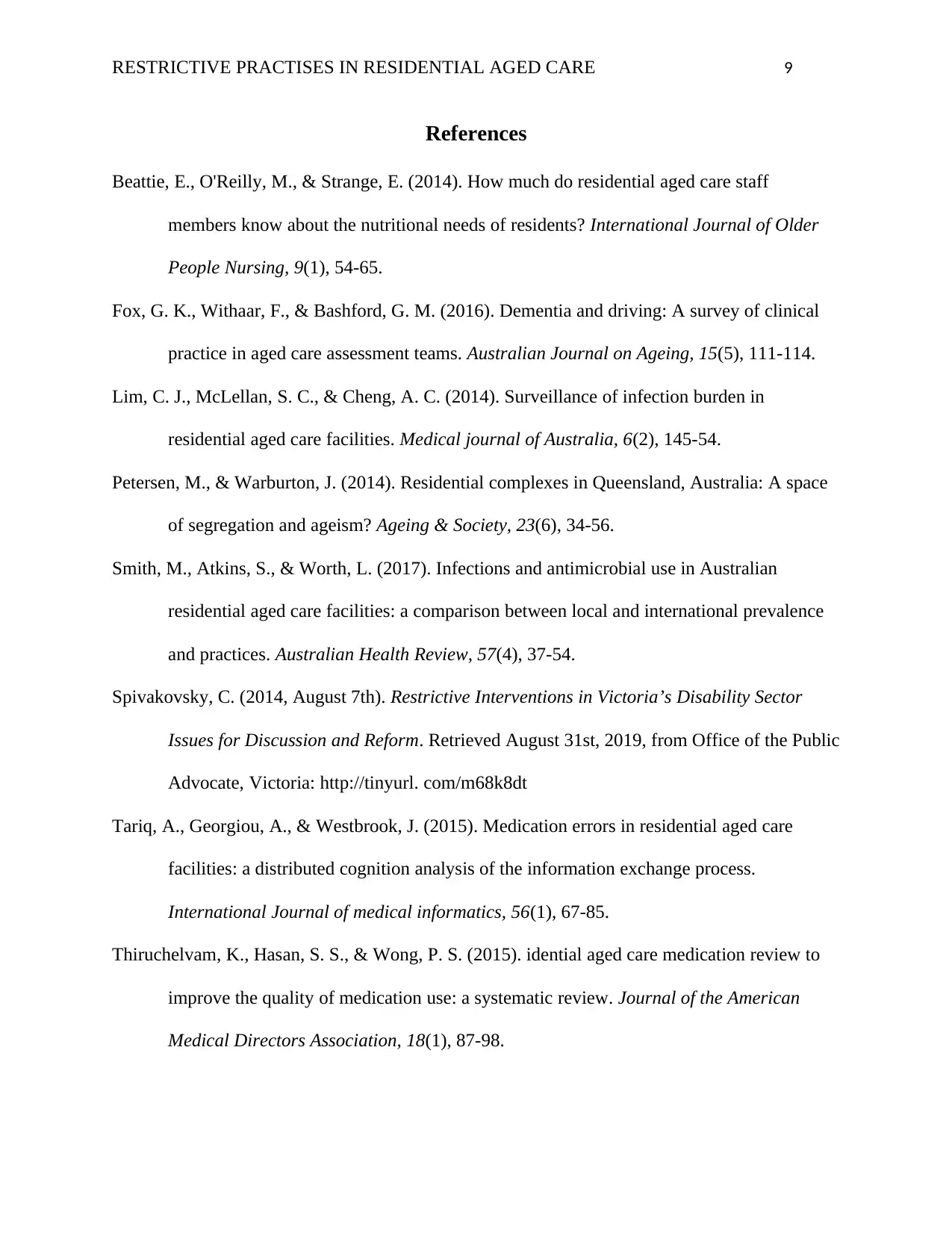
RESTRICTIVE PRACTISES IN RESIDENTIAL AGED CARE 9
References
Beattie, E., O'Reilly, M., & Strange, E. (2014). How much do residential aged care staff
members know about the nutritional needs of residents? International Journal of Older
People Nursing, 9(1), 54-65.
Fox, G. K., Withaar, F., & Bashford, G. M. (2016). Dementia and driving: A survey of clinical
practice in aged care assessment teams. Australian Journal on Ageing, 15(5), 111-114.
Lim, C. J., McLellan, S. C., & Cheng, A. C. (2014). Surveillance of infection burden in
residential aged care facilities. Medical journal of Australia, 6(2), 145-54.
Petersen, M., & Warburton, J. (2014). Residential complexes in Queensland, Australia: A space
of segregation and ageism? Ageing & Society, 23(6), 34-56.
Smith, M., Atkins, S., & Worth, L. (2017). Infections and antimicrobial use in Australian
residential aged care facilities: a comparison between local and international prevalence
and practices. Australian Health Review, 57(4), 37-54.
Spivakovsky, C. (2014, August 7th). Restrictive Interventions in Victoria’s Disability Sector
Issues for Discussion and Reform. Retrieved August 31st, 2019, from Office of the Public
Advocate, Victoria: http://tinyurl. com/m68k8dt
Tariq, A., Georgiou, A., & Westbrook, J. (2015). Medication errors in residential aged care
facilities: a distributed cognition analysis of the information exchange process.
International Journal of medical informatics, 56(1), 67-85.
Thiruchelvam, K., Hasan, S. S., & Wong, P. S. (2015). idential aged care medication review to
improve the quality of medication use: a systematic review. Journal of the American
Medical Directors Association, 18(1), 87-98.
References
Beattie, E., O'Reilly, M., & Strange, E. (2014). How much do residential aged care staff
members know about the nutritional needs of residents? International Journal of Older
People Nursing, 9(1), 54-65.
Fox, G. K., Withaar, F., & Bashford, G. M. (2016). Dementia and driving: A survey of clinical
practice in aged care assessment teams. Australian Journal on Ageing, 15(5), 111-114.
Lim, C. J., McLellan, S. C., & Cheng, A. C. (2014). Surveillance of infection burden in
residential aged care facilities. Medical journal of Australia, 6(2), 145-54.
Petersen, M., & Warburton, J. (2014). Residential complexes in Queensland, Australia: A space
of segregation and ageism? Ageing & Society, 23(6), 34-56.
Smith, M., Atkins, S., & Worth, L. (2017). Infections and antimicrobial use in Australian
residential aged care facilities: a comparison between local and international prevalence
and practices. Australian Health Review, 57(4), 37-54.
Spivakovsky, C. (2014, August 7th). Restrictive Interventions in Victoria’s Disability Sector
Issues for Discussion and Reform. Retrieved August 31st, 2019, from Office of the Public
Advocate, Victoria: http://tinyurl. com/m68k8dt
Tariq, A., Georgiou, A., & Westbrook, J. (2015). Medication errors in residential aged care
facilities: a distributed cognition analysis of the information exchange process.
International Journal of medical informatics, 56(1), 67-85.
Thiruchelvam, K., Hasan, S. S., & Wong, P. S. (2015). idential aged care medication review to
improve the quality of medication use: a systematic review. Journal of the American
Medical Directors Association, 18(1), 87-98.
⊘ This is a preview!⊘
Do you want full access?
Subscribe today to unlock all pages.

Trusted by 1+ million students worldwide
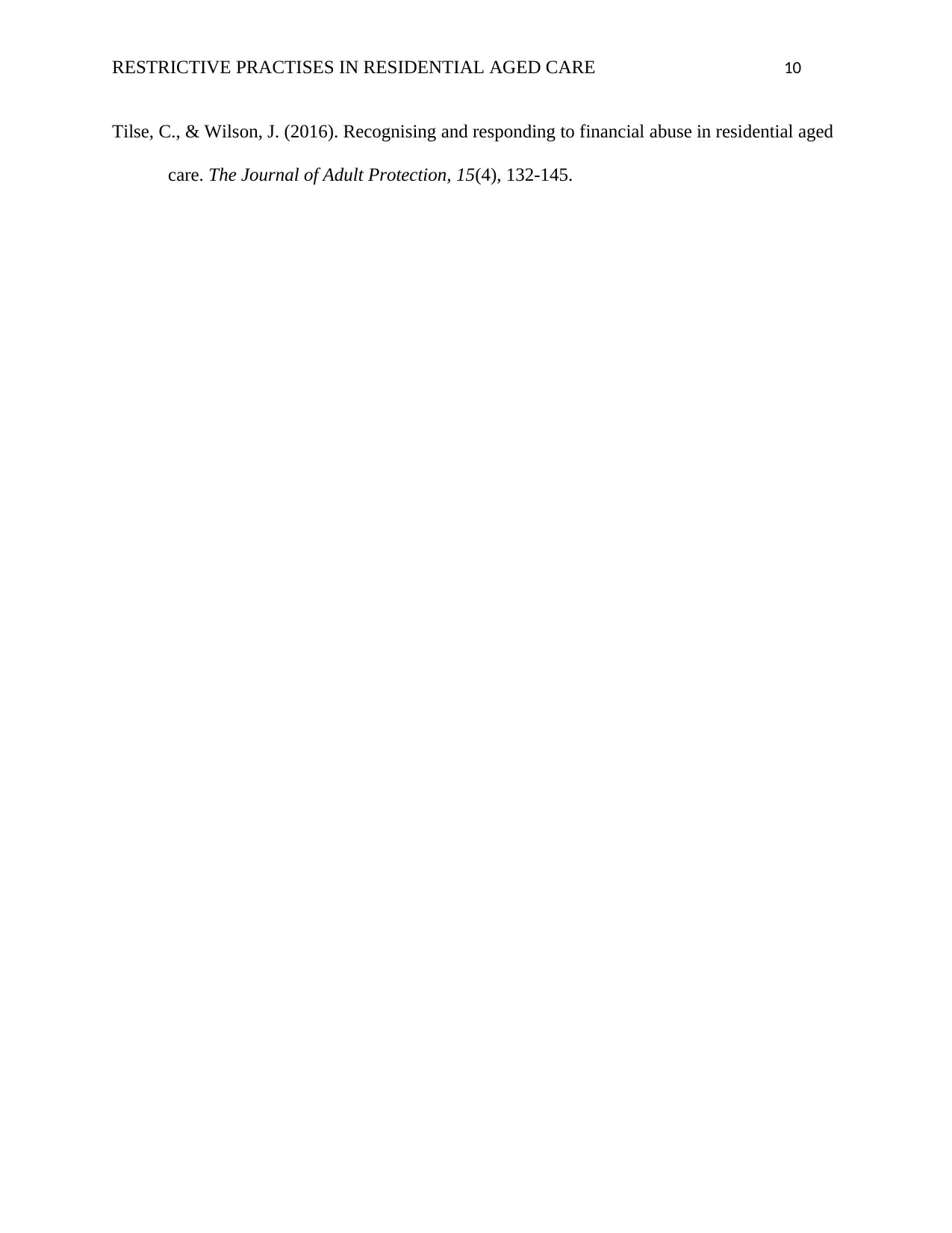
RESTRICTIVE PRACTISES IN RESIDENTIAL AGED CARE 10
Tilse, C., & Wilson, J. (2016). Recognising and responding to financial abuse in residential aged
care. The Journal of Adult Protection, 15(4), 132-145.
Tilse, C., & Wilson, J. (2016). Recognising and responding to financial abuse in residential aged
care. The Journal of Adult Protection, 15(4), 132-145.
1 out of 10
Your All-in-One AI-Powered Toolkit for Academic Success.
+13062052269
info@desklib.com
Available 24*7 on WhatsApp / Email
![[object Object]](/_next/static/media/star-bottom.7253800d.svg)
Unlock your academic potential
Copyright © 2020–2025 A2Z Services. All Rights Reserved. Developed and managed by ZUCOL.